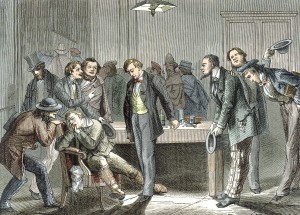
Figuier L. Les Merveilles de la Science ou Description Populaire des Inventions Modernes. Paris, 1868.
By Sarah Alger (Regular Contributor)
While in the dentist’s chair on a recent morning, I contemplated the fact that the mystery of what exactly happened one day in 1845 might in fact be a mystery about the human brain.
On January 21 of that year, Boston’s Daily Evening Transcript ran an ad by a gentleman who “wishes to introduce a new system of Surgery having especial reference to the Extracting of Teeth, by which nearly or quite all the pain which is usually caused by the operation may be avoided. The Doctor proposes to explain his theory to an audience at some public hall, and then proceed to perform operations in extracting teeth for those who will consent to undergo the operation.”
This Doctor, there is little doubt, was Horace Wells, a dentist from Hartford, Conn. His proposition, pain-free dentistry, was revolutionary. His system was the administration of nitrous oxide (laughing gas), with which he had successfully experimented on himself and some of his patients.
The details of his trip to Boston are unclear. He did end up recruiting a medical student to undergo tooth extraction in a public place, but the date and venue remain unconfirmed. Accounts differ about the demonstration itself; some witnesses did not notice any discomfort on the patient’s part, while others claimed he cried out in pain or did show discomfort, and as a result, declared the event a “humbug.” We do know that Wells thought perhaps he had stopped administering the gas too soon, and that he felt dejected, so much so that he returned to Hartford the next day.
My colleague and Massachusetts General Hospital archivist Jeffrey Mifflin notes that the young patient and his friends were planning to inhale nitrous oxide for fun after the demonstration. The patient, high on laughing gas and already in the party mood, might have cried out for the amusement of his friends, Jeff posits.
It was a year later that Wells’s former apprentice William T.G. Morton was responsible for the first successful public demonstration of anesthesia, using ether on a surgical patient at Massachusetts General Hospital (more on that story another time). Thus the field of anesthesia was officially born. Though the past 169 years have yielded refinements in anesthesia drugs and dosing, much remains to be understood about the brain under anesthesia.
Mass General anesthesiologist Emery Brown has spent much of his career pursuing this question, and last month, he published a paper that offers another possible explanation for Wells’s failure. In modern surgery, various types of ether are still in use, and patients are often switched from an ether to nitrous oxide toward the end of the surgery, allowing them to be more easily awakened.
In the paper, published in Clinical Neurophysiology, Brown and colleagues describe monitoring the EEG readings of 19 patients undergoing surgery. High doses of nitrous oxide cause patients to exhibit brain waves similar to those of deep sleep, yet for reasons still unknown, these waves are transient and return to a shallower, more easily rousable state. Wells might very well have administered enough gas; it might have been the patient’s brain that spoiled the fun.
